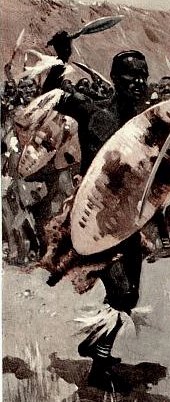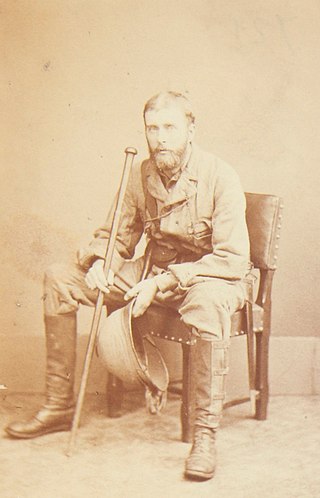Related Research Articles

Impi is a Nguni word meaning war or combat and by association any body of men gathered for war, for example impi ya masosha is a term denoting an army. Impi were formed from regiments from amakhanda. In English impi is often used to refer to a Zulu regiment, which is called an ibutho in Zulu or the army.

Shaka kaSenzangakhona, second name Shaka Zulu and Sigidi kaSenzangakhona, was the king of the Zulu Kingdom from 1816 to 1828. One of the most influential monarchs of the Zulus, he ordered wide-reaching reforms that re-organized the military into a formidable force.

The Anglo-Zulu War was fought in 1879 between the British Empire and the Zulu Kingdom. Following the passing of the British North America Act of 1867 forming a federation in Canada, Lord Carnarvon thought that a similar political effort, coupled with military campaigns, might lead to a ruling white minority over a black majority, which would provide a large pool of cheap labour for the British sugar plantations and mines, encompassing the African Kingdoms, tribal areas and Boer republics into South Africa. In 1874, Sir Bartle Frere was sent to South Africa as High Commissioner for the British Empire to effect such plans. Among the obstacles were the armed independent states of the South African Republic and the Kingdom of Zululand.

Cetshwayo kaMpande was the king of the Zulu Kingdom from 1873 to 1884 and its Commander in Chief during the Anglo-Zulu War of 1879. His name has been transliterated as Cetawayo, Cetewayo, Cetywajo and Ketchwayo. Cetshwayo consistently opposed the war and sought fruitlessly to make peace with the British, and was defeated and exiled following the Zulu defeat in the war. He was later allowed to return to Zululand, where he died in 1884.

The Battle of Kambula took place on 29 March 1879, during the Anglo-Zulu War, when a Zulu military force attacked the British camp at Kambula, having routed the mounted element of the British force at the Battle of Hlobane the day before. The battle was a decisive Zulu defeat and the Zulu warriors lost their belief in victory. The war ended after the Zulu defeat at the Battle of Ulundi on 4 July 1879.

The Battle of Hlobane took place at Hlobane, near the modern town of Vryheid in KwaZulu-Natal, South Africa during the Anglo-Zulu War.

The Natal Native Contingent was a large force of auxiliary soldiers in British South Africa, forming a substantial portion of the defence forces of the British colony of Natal. The Contingent saw action during the 1879 Anglo-Zulu War. The Natal Mounted Police was created in 1873 to bolster the defenses of Natal. It enlisted European officers, NCOs and natives. The infantry was created in 1878. Most enlisted troops were drawn from the Basuto and Mpondo tribes, which had had long experience fighting the Zulus.

The Nieuwe Republiek was a small Boer republic which existed from 1884 to 1888 in present-day South Africa. It was recognised only by Germany and the South African Republic. Its independence was proclaimed on August 16, 1884, with land donated by the Zulu Kingdom through a treaty. It covered 13,600 square kilometres (5,300 sq mi) and the capital was Vryheid or Vrijheid, both being alternative names of the state. The founder and president until it requested incorporation into the South African Republic on 20 July 1888 was Lucas Johannes Meyer, while Daniel Johannes Esselen acted as Secretary of State during the same period.
The military history of South Africa chronicles a vast time period and complex events from the dawn of history until the present time. It covers civil wars and wars of aggression and of self-defence both within South Africa and against it. It includes the history of battles fought in the territories of modern South Africa in neighbouring territories, in both world wars and in modern international conflicts.

The Mthethwa Paramountcy, sometimes referred to as the Mtetwa or Mthethwa Empire, was a Southern African state that arose in the 18th century south of Delagoa Bay and inland in eastern southern Africa. "Mthethwa" means "the one who rules".

The Zulu Kingdom, sometimes referred to as the Zulu Empire or the Kingdom of Zululand, was a monarchy in Southern Africa. During the 1810s, Shaka established a standing army that consolidated rival clans and built a large following which ruled a wide expanse of Southern Africa that extended along the coast of the Indian Ocean from the Tugela River in the south to the Pongola River in the north.

Dabulamanzi kaMpande was a Zulu commander for the Zulu kingdom in the Anglo-Zulu War. He is most noted for having commanded the Zulus at the Battle of Rorke's Drift. He was a half-brother of the Zulu king Cetshwayo.
Princess Mkabayi kaJama was a Zulu princess, the head of the Qulusi military kraal, and a regent of the Zulu Kingdom. She persuaded her father, the Zulu King Jama kaNdaba, to remarry, and acted as a regent during the reign of her half-brother, Senzangakhona.
The Battle of Holkrans or Holkrantz took place at Holkrans, near Vryheid in KwaZulu-Natal, South Africa during the second Anglo-Boer War.
uHamu kaNzibe or Hamu kaNzibe was a Zulu chieftain, half-brother and great rival of king Cetshwayo.
Ian Knight is a British historian and writer, specialising in Anglo-Zulu and Boers wars.
John Paul Clow Laband is a South African historian and writer, specialising in Anglo-Zulu and the First and Second Freedom Wars. He has taught at universities in South Africa, England, and Canada. In particular, he has been Professor of History at Wilfrid Laurier University, Canada, and a Research Associate of the University of KwaZulu-Natal.

Sihayo kaXongo was a Zulu inKosi (chief). In some contemporary British documents he is referred to as Sirhayo or Sirayo. He was an inDuna (commander) of the iNdabakawombe iButho and supported Cetshwayo in the 1856 Zulu Civil War. Under Cetshwayo, Sihayo was a chief of a key territory on the border with the British Colony of Natal and had a seat on the iBandla. Sihayo was an Anglophile who wore European clothes and maintained friendly relations with trader James Rorke who lived nearby at Rorke's Drift. By 1864, Sihayo was head of the Qungebe tribe and that year agreed a new western border of the kingdom with Boer leader Marthinus Wessel Pretorius.

The Zungwini Mountain skirmishes took place on 20, 22 and 24 January 1879 during the Anglo-Zulu War. The mountain was a stronghold of the AbaQulusi Zulu tribe, who were reinforced by the forces of exiled Swazi prince Mbilini waMswati. The mountain lay near the proposed route of advance of a British column under Lieutenant-Colonel Evelyn Wood, one of three that marched on the Zulu capital, Ulundi, from early January. Aware that the other columns had made less progress Wood, who had halted to fortify a camp at Tinta's Kraal, decided to deal with the abaQulusi strongholds.

Major-General John Cecil Russell (1839–1909) was a British cavalry officer. After a brief service with the Oxford University Rifle Volunteer Corps Russell purchased a commission in the 11th Light Dragoons in 1860. He transferred to the 10th Light Dragoons and rose to the rank of captain by purchase before transferring to the 12th Lancers in 1872. Russell served with Garnet Wolseley in the 1873–1874 Anglo-Ashanti War and was considered a member of the Wolseley ring of rising men. In 1875 he was appointed an Equerry in Waiting to Edward, Prince of Wales and became an Extra Equerry in 1878.
References
- ↑ Peter Warwick, Black People and the South African War 1899-1902, p. 91
- ↑ Ken Gillings, Discovering the Battlefields of the Anglo-Zulu War, pages 105-6
- ↑ abaQulusi - What's in the name?
- ↑ AbaQulusi in and around the Anglo-Boer South African War 1899-1902
- ↑ Laband, John (2009). Scarecrow Press (ed.). Historical Dictionary of the Zulu Wars. Lanham, Maryland. ISBN 978-0-8108-6078-0.
{{cite book}}: CS1 maint: location missing publisher (link) - ↑ The Battle of Holkrans